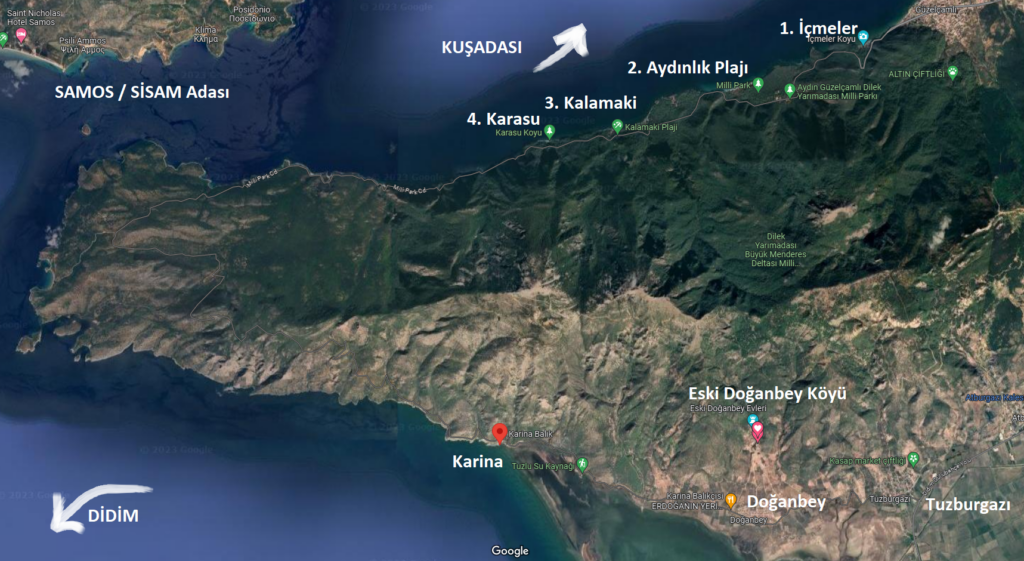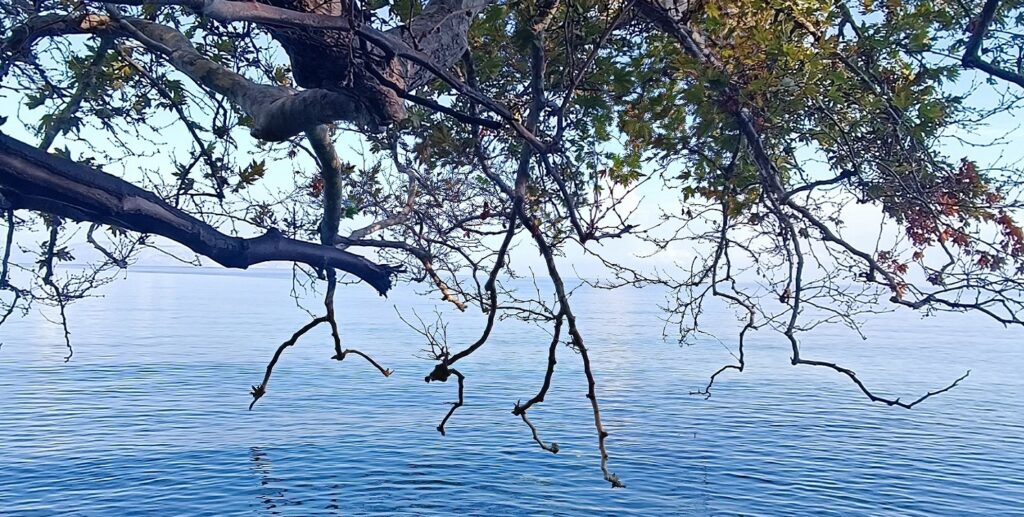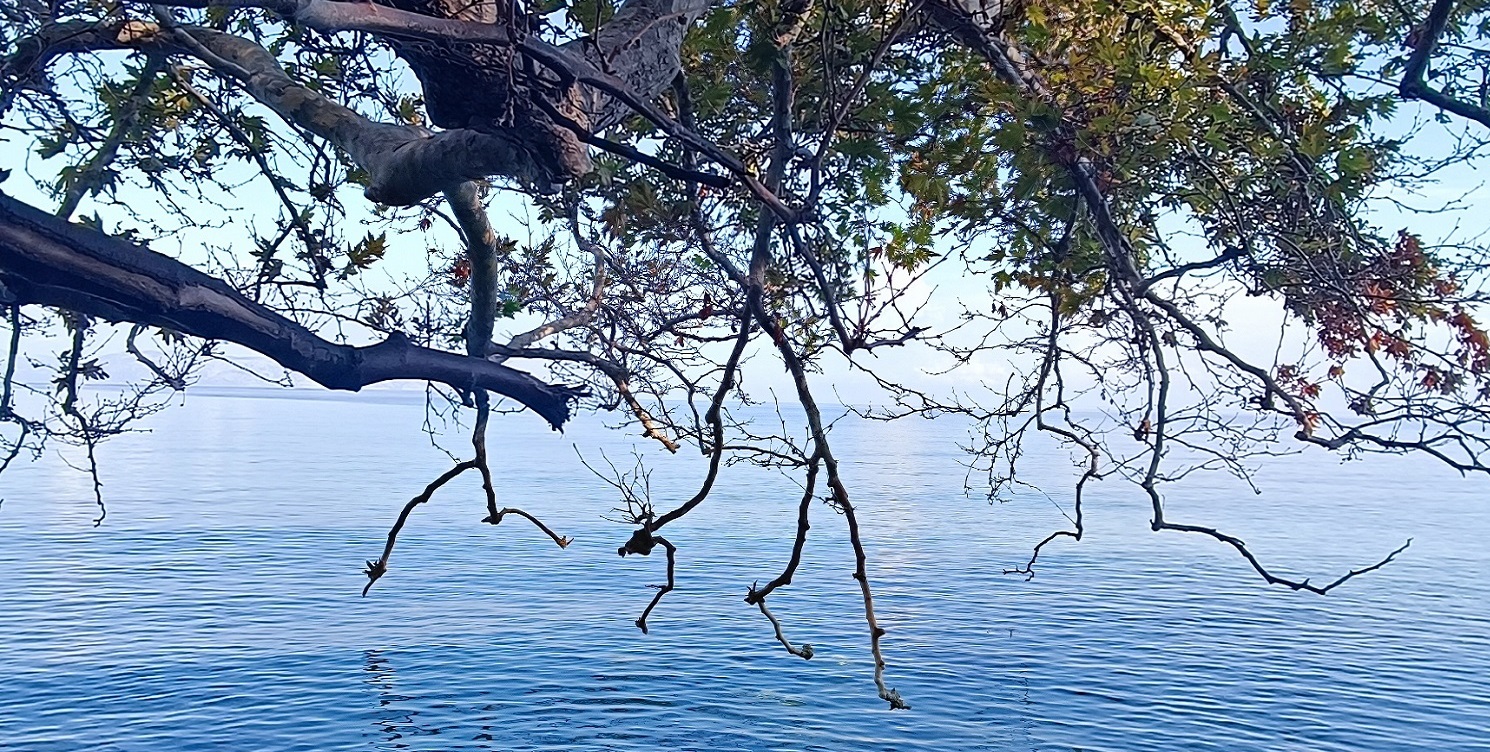Dilek Peninsula…
First of all, precise information: The national park, located at the last point where Dilek Mountain reaches the Aegean Sea, within the borders of Aydın province. It has an area of 27,675 hectares. 10,985 hectares of this area belong to Dilek Peninsula, which was declared a National Park on 19.05.1966, and 16,690 hectares to Büyük Menderes Delta, which was declared a National Park in 1994.

The Dilek Peninsula section of the National Park, opposite the Greek island of Samos, is the last point of the Samsun Mountains extending towards the Aegean Sea. The highest point of the peninsula, which has an average height of 650 m, is Dilek Tepe (Mykale), from which the National Park takes its name, and is 1237 m high. The National Park takes its name from this hill.
Panionion, the sacred gathering center of the Ionian city in the 9th century BC, the ancient city of Thebes, Ayayorgi Monastery, the historical Doğanbey Village (Domatia), Karine, Hagios Antonios Monastery and Zeus Cave are also within the borders of the National Park.
It is of international importance due to its rich biodiversity, endangered species and endemic species. The National Park is a protected area under the International Convention on Wetlands (Ramsar), the Convention on the Conservation of European Wildlife and Habitats (Bern), the Convention on Biological Diversity (Rio) and the Convention on the Protection of the Mediterranean Sea against Pollution (Barcelona). Dilek Peninsula – Büyük Menderes Delta National Park is an Important Natural Area as it is an Important Bird Area, an Important Flora Area and an Important Mammal Area.
Source: Wikipedia
Kuşadası Municipality National Park page:
Going to the Beaches
Technically, our Eski Doğanbey village is within the borders of the National Park. There is even a National Park Visitor Center at the entrance of the “Anatolian Side” of the village. There is general information about the peninsula, a huge model to help you visualize, and an informative exhibition about the creatures of the region. The building, which was used as a hospital and school in the past, has been restored and turned into a museum, and there are also meeting rooms and a cafe.

Also on the map, the Eski Doğanbey Village and the National Park Beaches are back to back… In other words, our village is exactly in line with one of the beaches in the north of the peninsula, on the southern slopes. There is even an exquisite hiking trail where you can go up to the mountains from the village and pass through the wonderful flora of the region. The other end of the 20 km track leads to the side of the road going to the beaches.
I shamefully admit that in the decades I’ve been here, I haven’t walked all of it. I took long walks on the dirt road that leads through the village to the western end of the peninsula; I walked to the delta past the old winery ruins here. I gathered flowers, sage and thyme from the mountains. I went up to the cliffs watching the village from above like a great wise grandfather and the thin waterfall called Şorlak, which flows through it. I even climbed the hill overlooking the village and the delta and shouted to the mountains as if I was the queen of these lands. I made similar walks from the back; I climbed the road up the beaches up to a point. But I never made the whole journey. Because it is not a commuting distance; there must be a vehicle waiting for you on the opposite side for your return. There have also been some tourists who were lost on the way; it is better if you have an expert or a guide with you.
Therefore, the most comfortable and conventional way to go to the beaches is to take a car and return back to Söke and cross the peninsula via a huge U. This journey will take approximately 45 minutes. While driving through (or around) Söke towards Kuşadası, there is a left turn; From here, you can go to Davutlar via Ağaçlı Village. From there, you can reach the official gate of the National Park Beaches from the summer residence town of Güzelçamlı. You pay a small amount of fee at the gate (in my last visit, the entrance with a vehicle was HGS or cash was 35 TL).
Beaches…
After entering the National Park, there are several beaches in a row. The first of these, İçmeler, is the most popular as it can be reached on foot or public transport. Therefore, it is the most crowded in the season. It makes sense to drive as there is quite a distance to the next beaches, but trackers and cyclists dare every now and then. There is also the opportunity to take in this turquoise-colored landscape with the view of Samos / Samos island and photograph it on the pleasant viewing terraces by the roadside.
Since Aydınlık Bay next is one of the biggest beaches, there are two entrances and exits from both the east and west ends. In between, there is a closed area where the Gendarmerie station is located. Karasu, located at the end, is also a beach where you can spend the day with pleasure, with wooden sun loungers, bamboo umbrellas and picnic tables.
There are facilities on all beaches including İçmeler (wc, cabins, showers, buffets) and all the ones after İçmeler are pebble beaches. Going forward after a point on the peninsula is illegal and the road is closed.
My personal preference is to leave early in the morning on weekdays and go to the farthest beach. Settling down at one of the seaside tables with my thermos, freezer and picnic basket. Especially if I find one in a tree shade, there is no one happier than me. If I lay my loincloth on the wooden chaise longues; I could spend the whole day here. I either have my book in my hand or my companion next to me with the most beautiful waters of the country stretching from blue to turquoise in front of me. And off course, the national park boars next to me!
Fauna…
You may have seen wild boars in many national parks; but here the situation is a little different. Because there are families of wild boars that are used to the crowds coming to the beaches, they do not run away from people. They even set up their homes next to easy food. The puppies are especially cute… You can spot them with their stripes, spots and squeaky sounds. Beware of their parents though; it’s not a good idea to be so intimate with them. No matter how humane they may have been, the boar can knock you down with a single move. In addition, it is useful not to leave the food in the open; they can also plunder your table. For example, last time they stole our corn and plums! They can quickly sweep away leftovers, watermelon peels, or whatever is left on the table.
Both the nature and the waters of this park is so untouched that not only pigs but also you can come across other wildlife . In all these years of my trips, apart from rabbits, foxes, turtles, squirrels, various birds and fish, I have aslo encountered a very special creature. Two years ago in 2021, while enjoying an ordinary swim, I was standing in the blue water up to my knees… I felt something on my leg, on my ankle. It was like someone was holding me. I looked down and a little octopus was strapped to my leg! Far from being afraid, my heart was filled with joy; I even felt grateful that this beautiful creature deemed me worthy of a hug. I slowly lifted my feet to take a closer look and to show that I was not a rock but a living creature. He didn’t let go; tightly wrapped. I took a few calm steps in the water; then he left. I like to think that it is a hug from the dear waters of the Aegean.
Back to the village…
National Park beaches are not open 24 hours and accommodation is not allowed. According to the season, it closes at 6-7 pm and the gendarmerie patrols to ensure that no one stays inside. There are also very charismatic mounted gendarmes patrolling throughout the day. After all, exit we must… We get in our car and set off with one last drink from the natural spring fountain next to the trail, one last pose on the viewing terraces and goodbye to the piglets.
We take the same way back to the village.This time, we slow down as we pass through Ağaçlı, where we had not stopped before. Because the huge flatbreads and pancakes here are famous. One time, we even finished the giant bread we bought to eat at home on the road!
Alternatively, as you pass through Söke, you can go through the Kemalpaşa neighborhood with preserved and restored old houses. Or you can satisfy your hunger in one of the skewers & steakhouses in the industrial zone. Home-cooking at Meltem Restaurant in Güllübahçe on the village road is also an option. Personally, I prefer to go home and sip my soft drink in the windy courtyard. But tastes and colors are indisputable.
